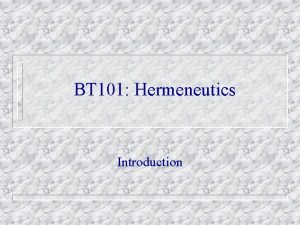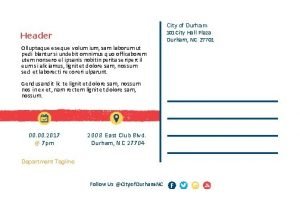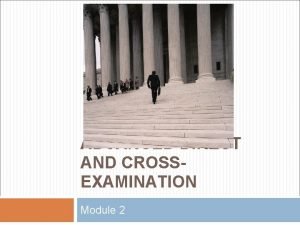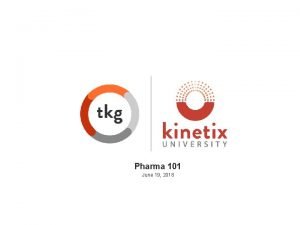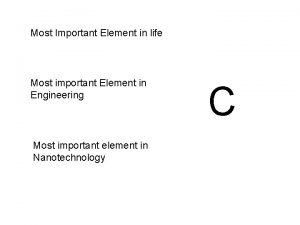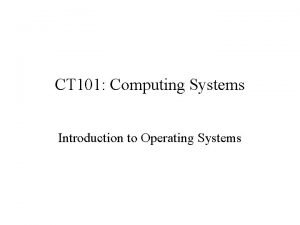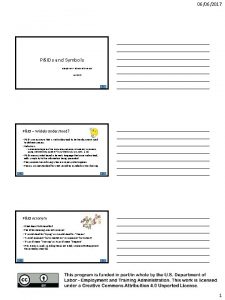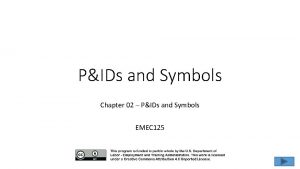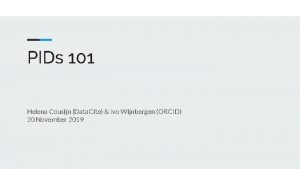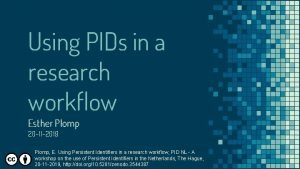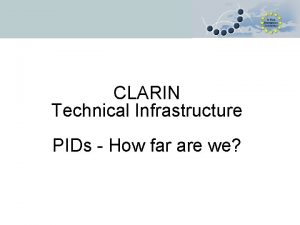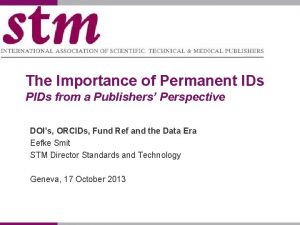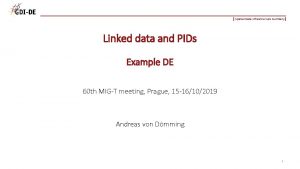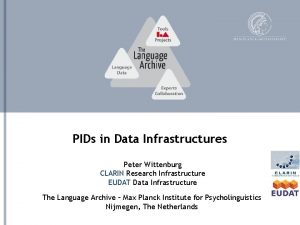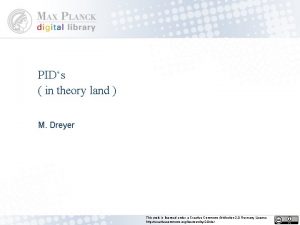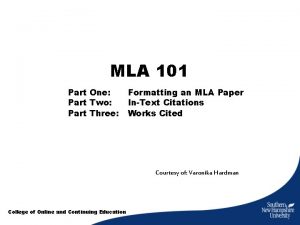PIDs 101 Part 1 of a 6 Part


































- Slides: 34

PIDs 101 Part 1 of a 6 -Part Webinar Series Mark Leggott, Maude Laplante Dubé, Eugene Barsky

Agenda 1. 2. 3. 4. Welcome and Housekeeping (CRKN - 5 minutes) The New RDC PIDs Document (Mark - 10 minutes) Context and Impact of PIDs (Maude - 15 minutes) Implementation of PIDs (Eugene - 15 minutes)

The New RDC Persistent IDs Document Mark Leggott

RDC PIDs Document - Version 1 ● 1 st version published in 2016 by Research Data Canada ○ ○ Working Group of the Standards and Interoperability Committee (SINC) Goal to promote adoption of best practices for PIDs with all stakeholders ● Overview, common PIDs, emerging PIDs, and recommendations ○ ○ Researchers Objects Organizations Equipment ● Recommendations targeted specific stakeholders ○ ○ ○ Funders Universities & Research Centres Government Departments Repositories and Publishers Researchers Canadian Research Data Management organizations

RDC PIDs Document - Version 2: New PID Discussions ● New Working Group struck in 2020 to update the document ● Overviews updated, and more PID sections added ○ ○ ○ Researcher Identifiers Research Outcome Object Identifiers Publications Datasets Research Software Organization Identifiers Funding Identifier Research Project Identifier Equipment Identifiers Physical Sample Identifiers (Geo, Bio, Health) Other Identifiers

RDC PIDs Document - Version 2: New Sections ● New Sections added ○ ○ The PID Framework The PID Landscape The Future of PIDs Governance and Sustainability ● Recommendations section updated and expanded ○ ○ Updates on original Recommendations Additional Recommendations and Stakeholders - NDRIO ● Open feedback stage ○ We are looking for broad community review and feedback by April 16/21

PIDs - A Complex Ecosystem

http: //bit. ly/rdc-pids-report

Context and Impact of PIDs Maude Laplante Dubé

A Brief Introduction to Persistent Identifiers, Their Uses and Their Potentiel for the Research Ecosystem ● ● What is a PID? A few words about persistence Types of PIDs Uses and potentiel of PIDs, illustrated

A Brief Introduction to Persistent Identifiers, Their Uses and Their Potentiel for the Research Ecosystem A few terminological and linguistic comments ● English: Persistent Identifier = PID ● French: ○ ○ Identifiant persistant? Identifiant pérenne? Identifiant permanent? IDP?

What is a PID? An IDentifier ● A string of unique characters that identify an entity (digital or real-world) ○ https: //doi. org/10. 2519/jospt. 1986. 7. 5. 273 ○ https: //orcid. org/0000 -0001 -8339 -2959 Persistent ● ● The ID itself, but also access to information about the identified entity ○ Metadata Long-lasting reference Exploitable ● Mechanism that leads to the resource and its metadata ○ URL

A Few Words About Persistence ● Not inherent to PIDs ● Depends on services from, and the long-term viability of, the agencies that register them and maintain their registries ○ Recognized? ○ Broad membership base? ○ Sustainable and interoperable infrastructure?

Sample DOIs ● ● DOI = ISO standard, under the authority of the International DOI Foundation (IDF) DOIs are registered by IDF-approved agencies ○ Cross. Ref, Datacite, etc. ● Cross. Ref ● DOIs mainly for scholarly publications ● Infrastructure for registration and long-term maintenance of a DOI resolver ● Requests metadata during registration ● Makes metadata available via a public API ● Offers other services based on its resolver ○ ○ Similarity Check Cross. Mark

Types of PID, by entity identified ORCID i. D, Scopus ID, ISNI, QID, etc. DOI, Pub. Med ID, Ar. Xiv ID, etc. ROR, GRID, Ringgold, ISNI, QID Ra. ID

Types of PID, by registration system System-specific PIDs Non system-specific PIDs Scopus. ID - Elsevier ORCID i. D - ORCID Ar. Xiv ID - Ar. XIV DOI - Cross. Ref, Datacite Pub. Med ID - Pub. Med ROR - California Digital Library/Cross. Ref/Datacite

Use and potentiel of PIDs – Quality citations and long-term access

Use and potentiel of PIDs – Facilitating retrieval

Use and potentiel of PIDs – Version control

Use and potentiel of PIDs - Measuring impact

Use and potentiel of PIDs – Disambiguation of resources L. V. Dorp Lucy Van Dorp

Use and potentiel of PIDs – Facilitating re-use

Advantages of PIDs for the research ecosystem - Facilitate discovery, re-use, interoperability Help to measure impact more accurately Reduce time required to retrieve information from different systems Facilitate data transfer between platforms

A Brief Introduction to Persistent Identifiers, Their Uses and Their Potentiel for the Research Ecosystem A few terminological and linguistic comments ● English: Persistent Identifier = PID ● French: ○ ○ Identifiant persistant? Identifiant pérenne? Identifiant permanent? IDP?

Implementation of PIDs Eugene Barsky

Implementation of PIDs ● First thing to know. . . it is always harder than it initially seems Case studies for implementing: - Handles, DOIs, ORCIDs, RORs Image by https: //www. flickr. com/photos/40032755@N 06/

Implementing Handles Purpose: Handles are persistent URL (and unlike DOIs come without associated metadata) ● Usually some repositories (Dspace, Dataverse, OJS) will have these built-in ● You still need to run a server to resolve handles and it could be a problem in large quantities ● Handles could be useful for unique use cases, in our example @UBC with licenced data access via Abacus Dataverse ● Handles are very cheap (around $50 a year for a prefix)

Implementing DOIs (1) Purpose: DOIs are persistent identifiers with metadata attached allowing great systems interoperability ● Some systems come with DOIs built-in, e. g. OJS or Dataverse, but you still have to pay for them ● Data. Cite Canada Consortium is managing DOIs services in Canada (CRKN/Portage), partially sponsored by NDRIO ● Minting DOIs makes your materials findable in ORCID, Google (if crosswalked to schema. org), and many others. . . Image - https: //www. flickr. com/photos/wakingtiger

Implementing DOIs (2) ● Custom DOIs minting is not cheap, although Datacite Fabrica goes a long way now ● DOIs are not panacea and require monitoring, especially if your institutions mints a lot ● In the UBC case, we have more than 260, 000 DOIs minted and we spend some time weekly to fix the metadata that does not validate Image - https: //www. flickr. com/photos/jdhancock/

Implementing DOIs (3) ● It is brilliant to see the Data. Cite Graph. QL API to query across PIDs systems (Datacite, ORCID, Crossref) ● I wish that it would be that simple of course : (

Implementing ORCIDs (1) Purpose: PID for researchers that records professional activities and disambiguates one researcher from another. ● Even less intuitive to implement, focus on systems interoperability ● Can embed in Dataverse, DSpace, and others, but the real value is by embedding in research information systems to allow interoperability and even populating faculty pages directly from ORCID ● Mc. Master Library worked hard in this direction , by integrating with Symplectic Elements (@Jay Brodeur) * Image - https: //www. flickr. com/photos/wwworks/

Implementing ORCIDs (2) ● Quite useful on an individual level, managing scholarly work

Implementing RORs Purpose: Globally-unique, stable, discoverable, and resolvable identifiers for research organizations, e. g. UBC https: //ror. org/03 rmrcq 20 Image - https: //www. flickr. com/photos/karola/ ● Works well with GRIDs ● Only a few implementations so far that I am seeing ● I like the one by Dryad. It allowed us to build a pipeline for UBC-authored datasets to be stewarded in our own repositories. We could only do it with RORs implemented, couldn’t do it before).

Summary comments ● PIDs are the backbone for scholarly publishing ● They tend to interoperate quite well (e. g. DOIs, ORCIDs, RORs) ● It is not perfect in any way, as anyone working in this area could confess ● But it will only get better! Image - https: //www. flickr. com/photos/centralasian/
 According to walter pauk, 10 weeks after lecture
According to walter pauk, 10 weeks after lecture Meerangdo leirangdo part 66
Meerangdo leirangdo part 66 Part part whole
Part part whole Part to part variation
Part to part variation Technical object description example
Technical object description example Addition symbol
Addition symbol Front bar is used for
Front bar is used for Unit ratio definition
Unit ratio definition The phase of the moon you see depends on ______.
The phase of the moon you see depends on ______. Historic tax credits 101
Historic tax credits 101 Refined grains
Refined grains Horse judging 101
Horse judging 101 Purpose of mechanical ventilation
Purpose of mechanical ventilation Phy101 lecture 1
Phy101 lecture 1 Ha gow
Ha gow Cs101 vu edu pk
Cs101 vu edu pk Equipment leasing 101
Equipment leasing 101 Hermeneutics 101
Hermeneutics 101 101 city hall plaza durham nc
101 city hall plaza durham nc Aka cpa
Aka cpa Html 101
Html 101 Brancusi
Brancusi Credit cards 101
Credit cards 101 Dau acq 101
Dau acq 101 Kjsd.powerschool.com/student
Kjsd.powerschool.com/student Crs 13-90-101
Crs 13-90-101 Healthcare landscape
Healthcare landscape Site:slidetodoc.com
Site:slidetodoc.com Dental class 1 2 3
Dental class 1 2 3 Uri aec tutoring
Uri aec tutoring Bridge building 101
Bridge building 101 L
L Operating system 101
Operating system 101 Shakespeare 101
Shakespeare 101 Algo101
Algo101

















